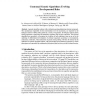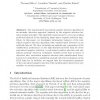99 search results - page 14 / 20 » Biological Inspiration for Artificial Immune Systems |
GECCO
2005
Springer
15 years 5 months ago
2005
Springer
This paper presents a novel approach of applying both positive selection and negative selection to supervised learning for anomaly detection. It first learns the patterns of the n...
IWINAC
2009
Springer
15 years 6 months ago
2009
Springer
Manifold initiatives try to utilize the operational principles of organisms and brains to develop alternative, biologically inspired computing paradigms. This paper reviews key fea...
147
click to vote
ECAL
1995
Springer
15 years 3 months ago
1995
Springer
A genetic algorithm scheme with a stochastic genotype/phenotype relation is proposed. The mechanisms responsible for this intermediate level of uncertainty, are inspired by the bio...
ALIFE
2005
14 years 11 months ago
2005
Recent years have seen the discovery of freely diffusing gaseous neurotransmitters, such as nitric oxide (NO), in biological nervous systems. A type of artificial neural network (A...
116
click to vote
ICARIS
2005
Springer
15 years 5 months ago
2005
Springer
The (randomized) real-valued negative selection algorithm is an anomaly detection approach, inspired by the negative selection immune system principle. The algorithm was proposed t...


